| THIS WEEK'S ARTICLES |
| The Market Message |
| A Three-Month Look at Sector Leadership Shows More Optimism |
| by John Murphy |
The last three months have seen rising stock prices. What's especially encouraging is which sectors have led the market higher. Chart 1 plots the sector performance over those three months. The top five sectors have been energy, financials, materials, industrials, and consumer cyclicals. All five are economically-sensitive stock groups that do better in a stronger economy. At the same time, the three weakest sectors have been utilities, staples, and real estate. All three are defensive in nature.
Rising commodity prices and rising bond yields may also explain some of that sector performance. Energy and materials, for example, are benefiting from rising commodity prices as part of the reflation trade. Rising bond yields have helped financials become market leaders. That may also explain the relatively weak performance by bond proxies like utilities and REITs. Rising bond yields may have also contributed to a rotation out of large technology growth stocks and into more value-oriented cyclical stocks. That rotation has helped to broaden out the market rally which is another encouraging sign. But it has pushed technology to the lower end of the leader board. And may explain why the largest tech stocks have spent the last three months trading sideways while the rest of the market has been rallying.
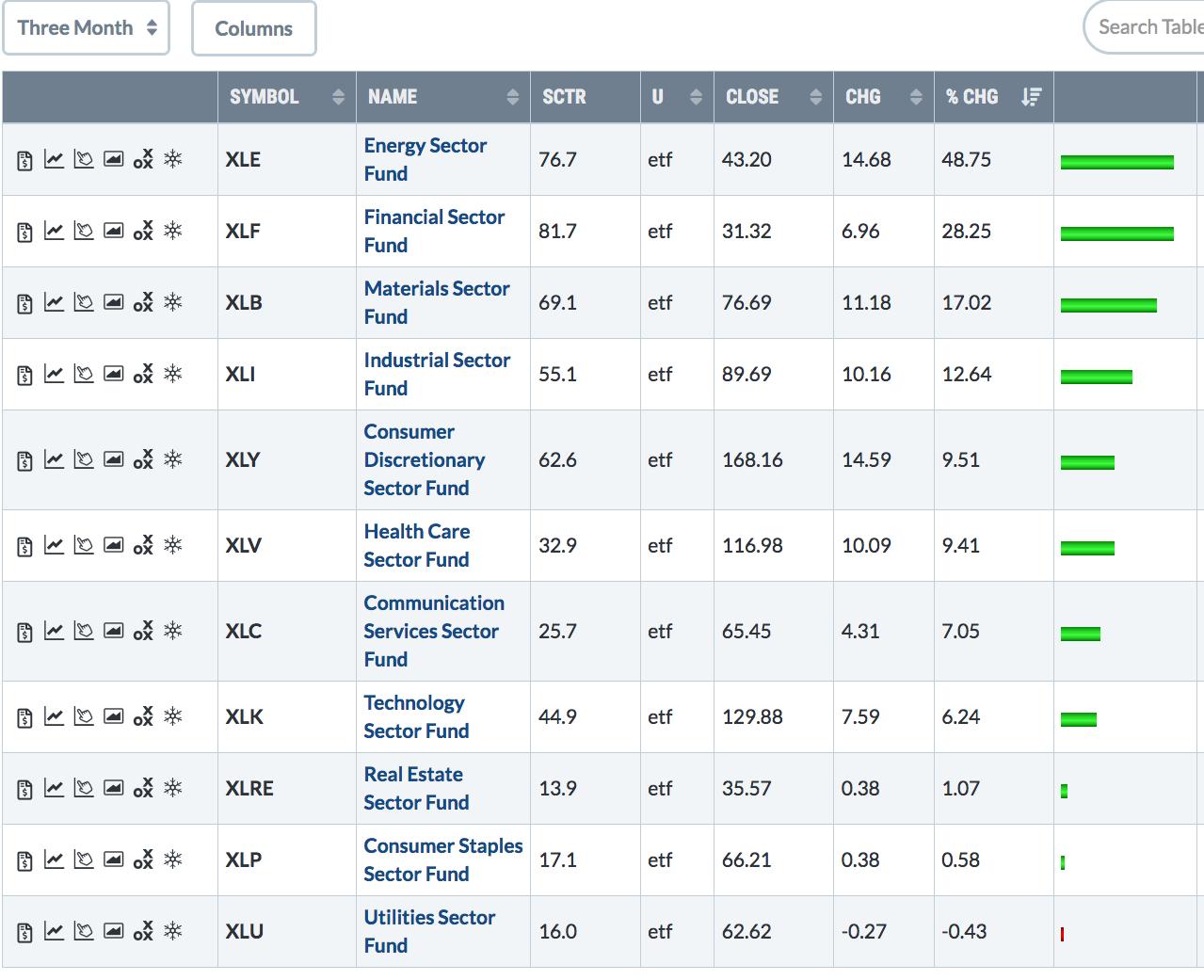 Chart 1 Chart 1
Editor's Note: This is an article that was originally published in John Murphy's Market Message on Thursday, January 14th at 2:28pm ET.
|
| READ ONLINE → |
|
|
|
| The Mindful Investor |
| Gold Hints at Further Downside |
| by David Keller |
Back in early December, we discussed the three signals we would need to see to turn bullish on gold and gold stocks. Although the picture for gold turned more positive that month, a failure at resistance and a return below the 200-day moving average suggest further weakness may be in store for precious metals.
The RSI level on gold may be one of the most important gauges of trend direction. After the August peak, gold pounded out a pattern of lower highs and lower lows while the RSI never reached much above the 60 level on bounces higher. This kept the RSI in a bearish range and confirmed the negative price trend.
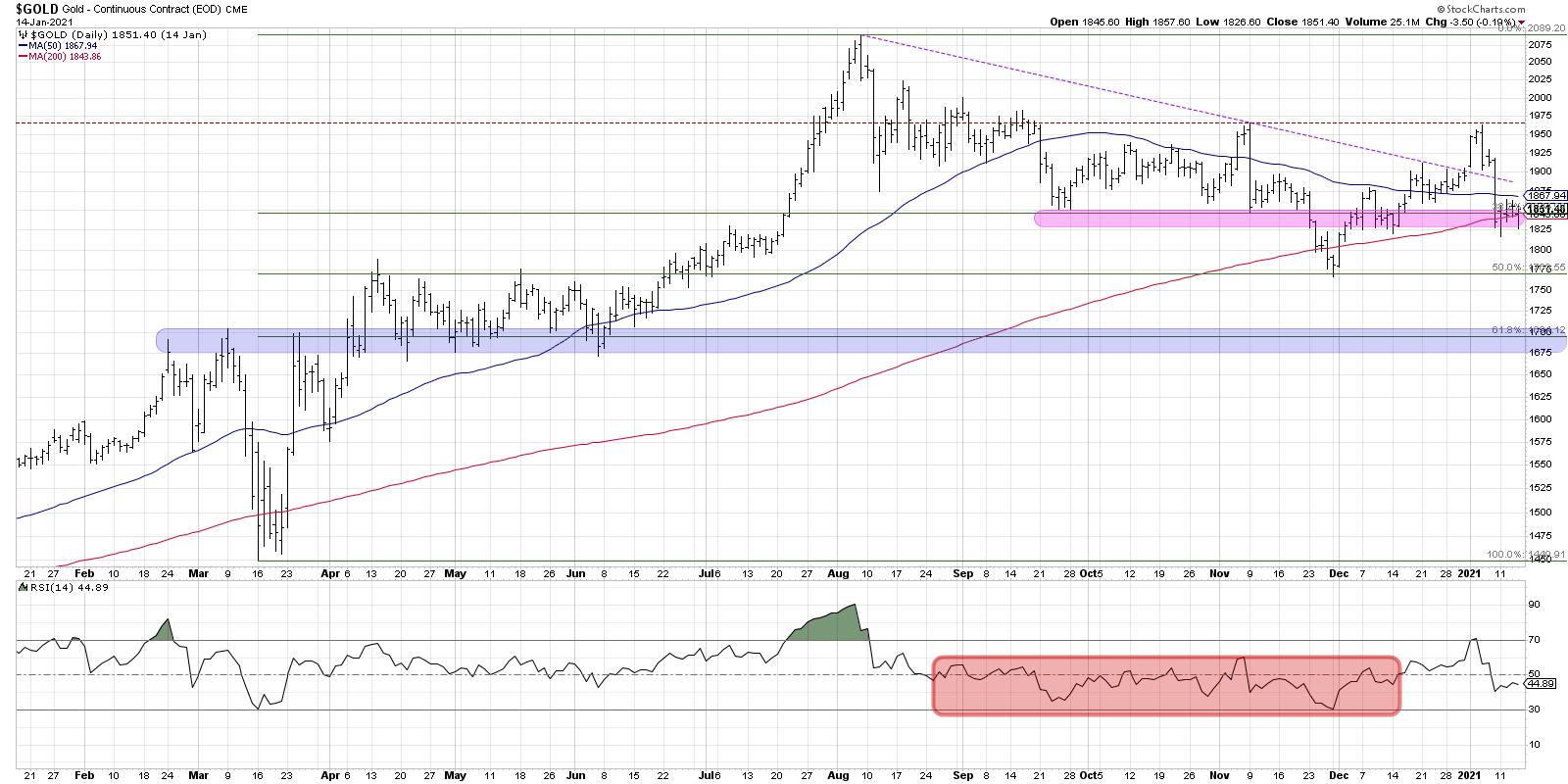
The yellow metal rallied soon after our article in December and everything seemed quite bullish, as gold and the GLD broke above trendline resistance using the August and November highs. After the new year, this trendline was broken as gold reached its previous swing high from November.
I discussed gold on Bloomberg TV during the last week of 2020, and later tweeted out that the run was impressive, but that you just needed to see a break to a new swing high to confirm the transition from distribution phase to accumulation phase.
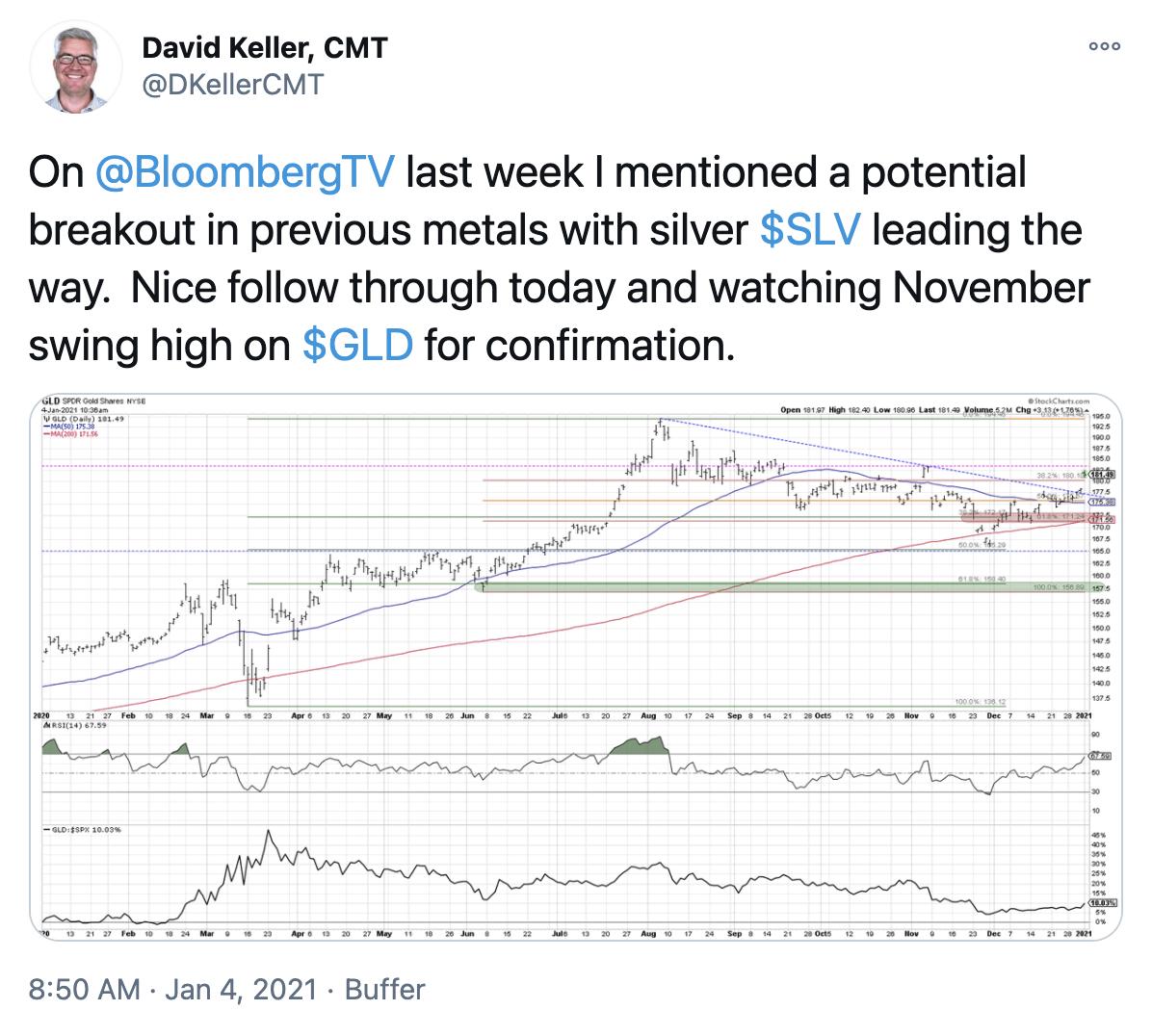
Alas, it was not to be. The November high around 1965 repelled the price advance, and gold has once again reverted back to previous swing lows.
So now we have a bit of a mixed bag of technical evidence to deal with. The RSI remains in a bullish range, with a recent overbought signal and the latest price drop seeing an RSI around 40, which is consistent with bullish phases. Friday's selloff in gold may be enough to push the RSI below 40, however, which would indicate a new bearish phase for precious metals.
The price has pushed back below its 200-day moving average, which, on the surface, is a bearish signal for any trend-follower. This shows that the short-term trend is dipping below its long-term average and indicates more of a bearish posture. However, the last two times gold dipped below its 200-day (November 2020 and March 2020), this phenomenon was short-lived. In both cases, the price quickly reverted back above this smoothing mechanism and resulted in a new swing high.
In a choppy and range-bound chart, support and resistance levels become even more vital. A break lower would suggest potential support at the November low (1770), with ultimate support resting around the 1700 level. That would be a 61.8% retracement of the March to August bull move and would also line up with plenty of support from last spring's lows.
What would suggest that my bearish thesis is incorrect?
First, gold would need to display a similar pattern to 2020, where breaks below the 200-day moving average were short-lived. Second, the RSI would need to remain more in a bullish range, then dip deeper into its bearish range. Most importantly, any bearish thesis would be negated by a break above the key resistance level of 1965. Until then, the path of least resistance appears to be lower.
RR#6,
Dave
David Keller, CMT
Chief Market Strategist
StockCharts.com
Disclaimer: This blog is for educational purposes only and should not be construed as financial advice. The ideas and strategies should never be used without first assessing your own personal and financial situation, or without consulting a financial professional.
The author does hold a position in GLD at the time of publication. Any opinions expressed herein are solely those of the author, and do not in any way represent the views or opinions of any other person or entity.
|
| READ ONLINE → |
|
|
|
| Trading Places |
| My Stock-Picking Secrets To Beat The Benchmark S&P 500 |
| by Tom Bowley |
All of the stocks and ETFs in our 5 current portfolios are "drafted" in real time during our members-only events that we hold quarterly. I don't Monday Morning quarterback; I listen to what Wall Street is saying and stick with the themes that are driving big money.
It's almost counterintuitive, because leading stocks are almost always overbought. Our mental composition many times won't allow us to pay more for a stock than we could have paid last week, month or quarter. So we try to convince ourselves that a stock is not worth the price that it currently trades. When it does finally pull back a bit, we convince ourselves that a bigger drop is imminent and we pass on the buying opportunity. It's happened over and over and over again with our portfolio stocks. When we "draft" our stocks, we simply pay the current price for all 10 of our equal-weighted stocks in each portfolio. We don't try to time it.
That strategy isn't for everyone and I get it. It's hard to pull the trigger after a stock has already made a significant advance. When I announced our latest Model Portfolio stocks at EarningsBeats.com on November 19th and selected Tesla (TSLA), it had just closed at 499.27, its highest close in history. Many EarningsBeats.com members asked, "Should I wait for a pullback?" My answer is always the same: members have to make decisions that are most comfortable for them. Everyone is different.
We buy as of that day's close, no exceptions, and we hold a full three months. I believe it's important to be transparent and disciplined. It also makes it very easy for those members who simply don't want to follow the market every single day, trying to make emotional decisions about when to buy or sell. For what it's worth, TSLA never pulled back and it's up 69% since our selection date.
All of the information that we share and produce at EarningsBeats.com is educational. I believe we have the best research and educational platform anywhere. Our members include those who trade, those who manage their investment portfolio/retirement assets and plenty of professionals managing money for themselves and others. We offer stock services and, more recently, ETF services. The results in our portfolios have been stunning.
Our Objective: Beat the S&P 500
Everyone should have a goal, whether it's investing, working your way up the corporate ladder, coaching a youth sports teams, whatever. Our goal is to provide a research and educational platform that helps our members beat the S&P 500. Our portfolios, which I consider to be an educational product, are designed utilizing the tools and strategies that we constantly strive to improve. For the current quarter and since their respective inceptions through Thursday's close, here is the performance of each of our stock portfolios:
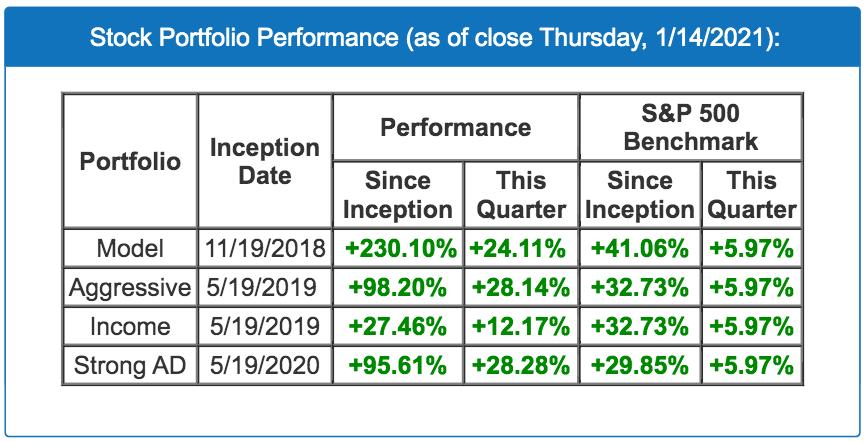
Model ETF Portfolio
Our Model ETF Portfolio commenced on October 19, 2020, and performance is not yet incorporated onto our website, but here's the updated performance through Thursday's close:
Current Quarter (10/19 - 1/14): +17.18% (S&P 500: +10.76%)
Outperforming the benchmark by more than 6 percentage points in less than 3 months by investing in 8 different ETFs is outstanding and, quite honestly, better than I would have expected.
The EarningsBeats.com Approach
Here at EarningsBeats, we simply marry excellent fundamentals with stout technicals. Seems easy enough. Yet the results have been stunning. All of our stock portfolios contain 10 equal-weighted leading stocks (at the beginning of each quarter) in 10 different leading industries (most cases). Every stock MUST have beaten Wall Street estimates as to both revenues and EPS in its latest quarterly earnings report. The Strong AD Portfolio is the only portfolio where we allow any exceptions to this rule, but those exceptions are rare.
The following stocks are the 10 stocks that make up our current Aggressive Portfolio, which is beating the S&P 500 by more than 22 percentage points in just under two months:
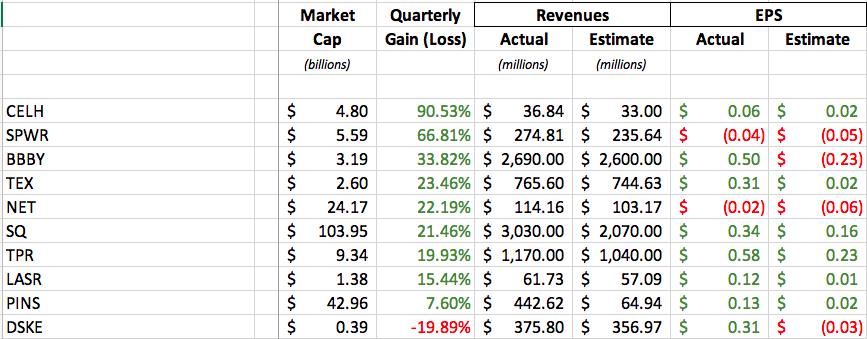
Several points to consider:
- 7 of the 10 stocks are either small-cap or mid-cap stocks
- All 10 stocks beat Wall Street estimates, several by very wide margins
- The stocks are ranked in order of quarterly gains (to date)
- SPWR and BBBY are both on our Short Squeeze ChartList, indicative of extremely high short % of float
- Just one stock, like CELH and its 90% gain, can carry a portfolio
Recognizing Themes
Just before our last portfolio "draft," we had two major positive vaccine announcements, which changed the market's focus and rotation. One of those changes was the emerging leadership of small caps. Check out this relative performance chart of the S&P 600 Small Cap Index ($SML) vs. the benchmark S&P 500 Index ($SPX):
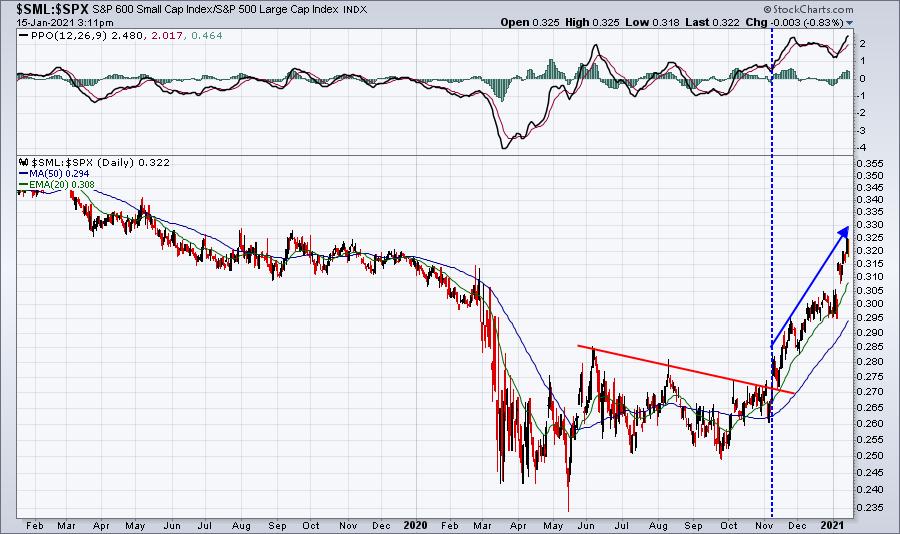
Small caps broke out relative to their large cap counterparts just before our last draft. As a result, we wanted our Aggressive Portfolio to hold a majority of small- and mid-cap stocks. It was a very deliberate change to our strategy based on market conditions at that time. The four best performers in our portfolio are small caps.
Perhaps the most critical element in understanding the current secular bull market is that rapid expansion of earnings will be handsomely rewarded in a historically-low interest rate environment. If you want to compare PE ratios now to prior market tops, go ahead and do so..... at your own peril. From my background in public accounting, I can tell you that rising earnings combined with lower interest rates will trigger massive increases in market value. The most important thing to understand is there are NO investing alternatives that compare to equities. Everyone will bid shares higher, because there's nothing else to do with your money.
Strategizing to Select the Right ETFs
Exchange-traded funds (ETFs) are a bit of a different story in that we don't have any control over the stocks that we invest in. We're relying entirely on the fund. But we can still control the makeup of our ETF portfolio, ensuring that we have exposure in the areas we want. For instance, back in October 2020, when we started the Model ETF Portfolio, one theme that really stood out was the online retail area. The Amplify Online Retail ETF (IBUY) chart is shown below:
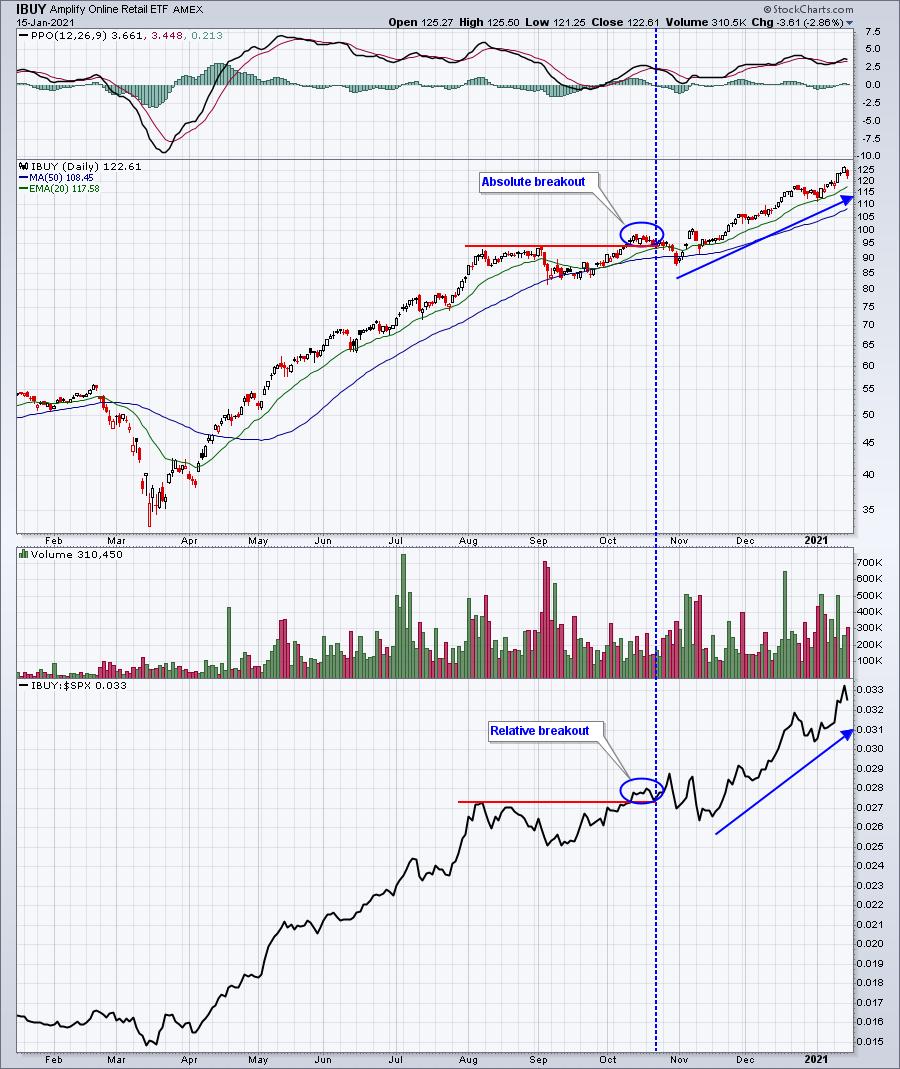
The absolute and relative breakouts were a primary reason that the IBUY was our most heavily-weighted ETF for the current quarter.
On Tuesday, January 19th, I'll be hosting our next Model ETF Portfolio "Draft" announcing the next group of ETFs that we'll have in our portfolio for the next 3 months. On Monday, I'll discuss a very strong ETF in our free EB Digest newsletter that I may end up including in our Model ETF Portfolio. CLICK HERE to subscribe and receive Monday's article.
By the way, if you prefer trading ETFs over individual stocks, you'll likely be very interested in an event that we had last week, "Building an ETF Portfolio the Right Way." We recorded the event and it's free at YouTube. Various topics are time-stamped for your convenience. Be sure to subscribe to our channel while you're there.
Happy trading!
Tom
|
| READ ONLINE → |
|
|
|
|
|
| The Traders Journal |
| How To Draft Stocks With A Profitable "Personality" And Build A Winning Portfolio |
| by Gatis Roze |
 FACT: If you investigate the skill sets of the top tier General Managers of your favorite pro sports league, you'll recognize uncanny parallels to the top tier traders described in the Market Wizard books. This is not a coincidence. FACT: If you investigate the skill sets of the top tier General Managers of your favorite pro sports league, you'll recognize uncanny parallels to the top tier traders described in the Market Wizard books. This is not a coincidence.
Some 20 years ago, I discovered a breakthrough that sharpened my perspective on individual stocks and has contributed mightily to my long-term consistent profitability. I draft my stock portfolio in much the same way GMs draft players for their teams.
In all sports arenas across the world, a recurring quote one hears is "just because that big name athlete is available, doesn't mean they're a good fit for our team." To reframe it in my own words, "I'll only draft a stock if I deem its personality appropriate for my portfolio." Allow me to explain.
I know — I can hear you saying that stocks aren't athletes. They aren't human, and they don't have a personality. But oh yes they do! And the more you understand this, the more likely you'll be to build a championship-winning portfolio.
This blog probably should have been a stand-alone chapter in our book, Tensile Trading. Nevertheless, I'll try to reduce it down to its essential core. First and foremost, I'm a chartist or technician. Give me any stock chart and I can wax on for an hour describing it's trading history, its unique volume behavior, trading ranges, momentum characteristics, appropriate moving averages, the attributes of its rallies and reactions, etc.
This is similar to a GM sizing up the technical absolutes of athletes — their speed, height and weight, their strength, reaction times, etc. Stocks' chart technicals make up a portion of their personality in the same basic way that a GM might see potential players. With respect to stocks, this first cut for me eliminates many equities immediately because they don't have a technical personality that I'm comfortable with. In other words, they're not a good fit for my team.
For example, a technically-deformed simple case is Bitcoin. For a whole host of reasons, I don't like its personality. Technically speaking, if Bitcoin were a person, it would be an unpredictable drug addict. Fine perhaps for some other trader's team portfolio, but I'll pass.
Next, I look to the stock's fundamentals. I'm an earnings junkie. Have earnings surprises been mostly positive? Have earnings consistently trended higher and are the analysts raising their projections on both growth and earnings? How do earnings per share and financial ratios compare to sister stocks in the same industry?
This is not unlike how our sports General Managers would be researching the personal fundamentals of particular athletes. How does the athlete's sports IQ stack up to the other players? Do they have the emotional discipline, commitment and work ethic to grow into first-tier outperformers? Do they have the personality to fit seamlessly into the team's culture?
Finally , I consider a stock's intangibles. What does my portfolio need metaphorically to fill the specific seats in my symphony orchestra? Do I need more growth stocks, large caps or mid-caps? Do I need more international or domestic ones? What about specific sectors or industries, and so on? It's all about balance.
I once saw a professional hockey scouting report, and the intangibles portion was surprisingly lengthy. It listed details about a players's parents (both of whom had been professional athletes), chronicled all the athlete's injuries and rehabilitation regimes, potential salary estimates and which positions and team needs the player might fill. Not unlike our portfolios, it's all about fit.
After years of investing, my intuition is such that I can become deeply familiar with most any stock within five minutes and can determine if its personality is appropriate for my portfolio or if it's an inappropriate faceless gremlin. Not dissimilar to GMs who have to perform — as do their players — or else they'll be gone. They must never forget that pro sports is a business above all else. Investors would be well served to adopt this same mentality. Investing with a business mindset is the goal.
There's an entirely separate blog I could write about using a stock's "personality changes" as a trigger to exit your position. It's a true "bell ringer" when an equity begins behaving out of character , but that'll be for another day. For now, I'll leave you with one of my favorite Zen proverbs:
"Knowledge is learning something every day. Wisdom is letting go of something every day."
Trade well; trade with discipline!
- Gatis Roze, MBA, CMT
StockMarketMastery.com
|
| READ ONLINE → |
|
|
|
| RRG Charts |
| The World is Outperforming the US |
| by Julius de Kempenaer |

Relative Rotation Graphs, or RRGs, can help you get a better view of the big picture.
One of the RRGs I often use to get a handle on international developments on stock markets around the world is to pull up the Relative Rotation Graph for international stock market indexes, as shown below.
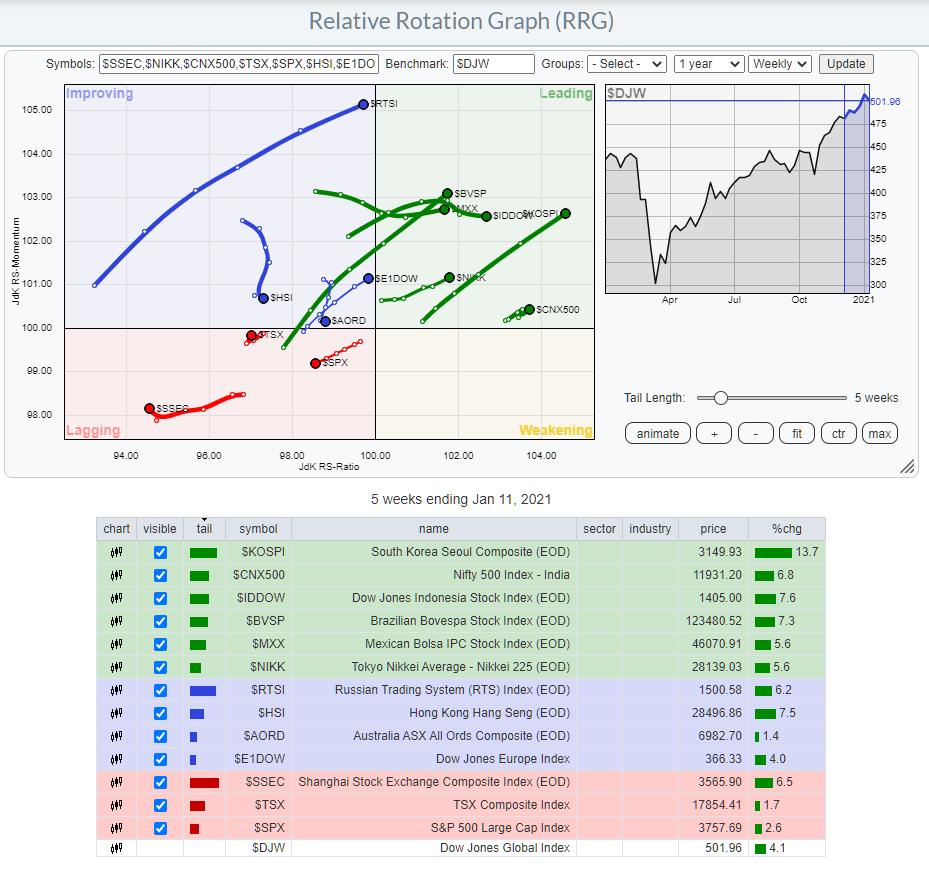
This chart shows the rotations for various international stock market indexes, using the Dow Jones Global index as the benchmark.
A word of caution!!
I know many of you like to trade ETFs, and that's all cool. In particular, if you want to benefit from performance in overseas markets, they are an easy way to do that. HOWEVER!! Be careful. The ETFs that are quoted on US exchanges are quoted in US dollars, while the stock markets that they are tracking around the world are trading in their local (different from USD) currencies.
This implies that, whenever you buy an ETF that tracks a foreign market which is not trading their stocks in USD, you are de facto "inheriting" a currency position with that trade. That's not necessarily a bad thing as long as you are aware of this. And, unfortunately, I still come across many people who are just not aware of this currency effect.
So for my analysis purposes, I prefer to use the underlying indexes - not only on an RRG but also on regular charts, as they represent the true buying and selling that is going on in that market. The USD-quoted ETFs allow us to easily create exposure to that market, and the price of that ETF is simply the index it is tracking multiplied with the xxx/USD currency value for that index.
The RRG above shows the US inside the lagging quadrant traveling at a negative RRG-Heading, going further into negative territory. And it is the only market on the chart with a truly negative heading.
China, also inside the lagging quadrant, has just, albeit slowly, started to pick up some relative momentum, as did Canada ($TSX).
Inside the improving quadrant we find Hong Kong and Australia moving lower on the JdK RS-Momentum scale while stable in terms of RS-Ratio. Inside the leading quadrant, Indonesia and Mexico have leveled off on the RS-Momentum scale, but still moving higher in terms of RS-Ratio.
ALL OTHER markets are at a strong RRG-Heading, gaining strength on both axes. Looking at the length and the direction of the tails in combination with their positions on the RRG, a few indexes deserve a bit of extra attention. I have isolated them on the RRG below.
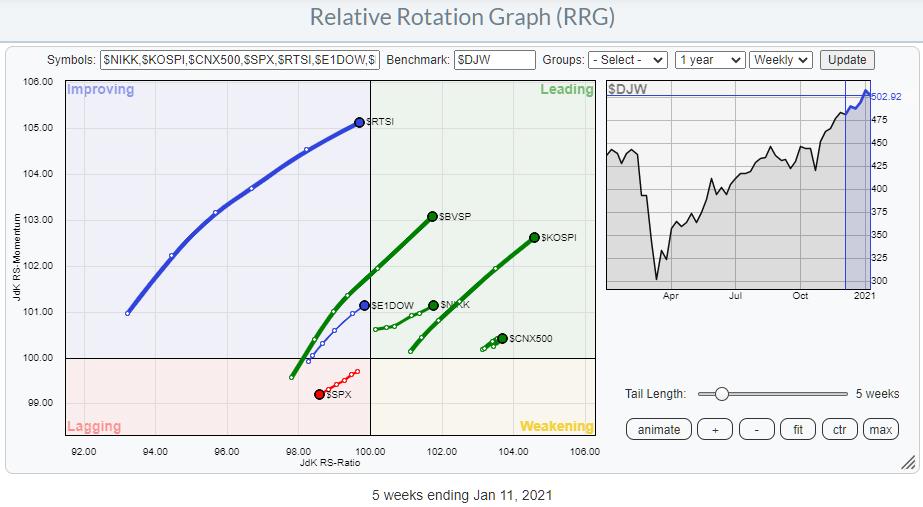
Let's take a look at the individual charts.
Russia ($RTSI)
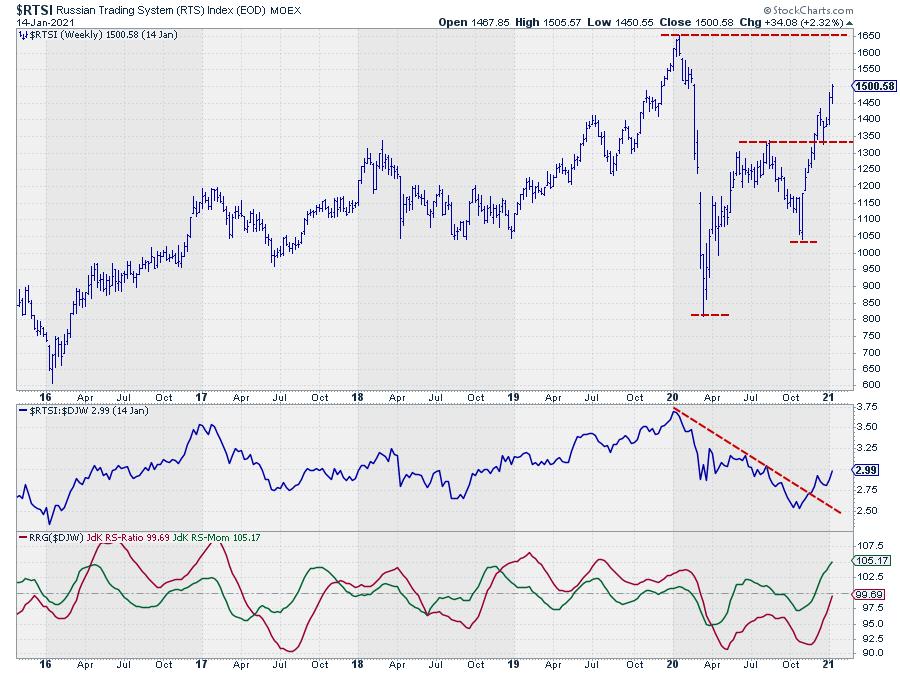
Relative strength broke its downtrend a few months ago and the new up-move is being picked up by the RRG-Lines, which are both pushing higher, positioning $RTSI inside the improving quadrant at a very high RS-Momentum level. The crossover into leading from improving is only a matter of time.
The recent break above 1325 was a good confirmation of the new uptrend that is underway, with new higher highs and higher lows. The next area of resistance is found near 1650, where the last major peak was formed.
Brazil ($BVSP)
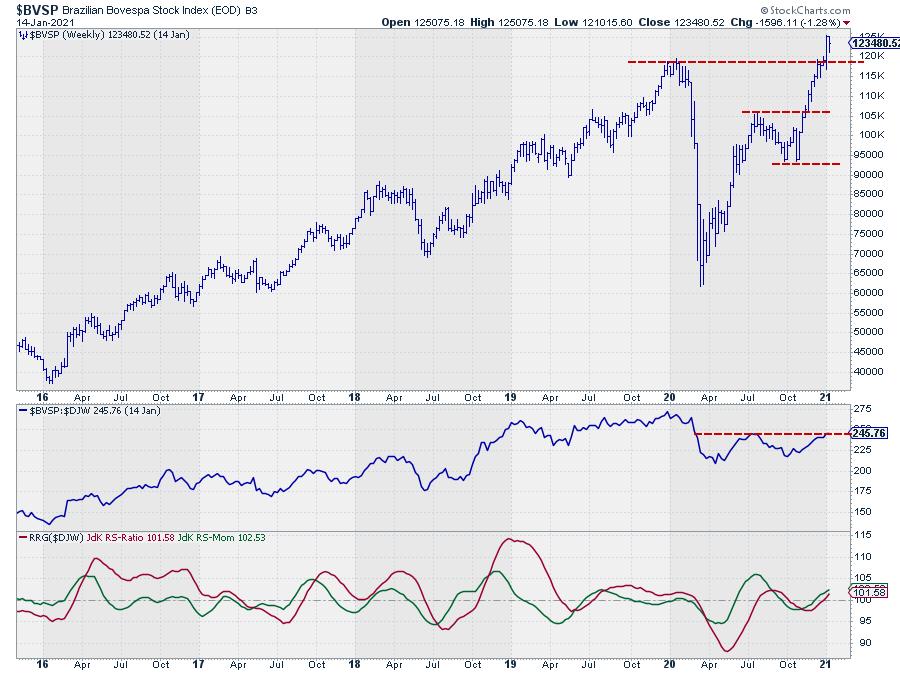
I actually wrote about the Brazilian market and the break to new all-time-highs in a DITC article. Read here: Brazil is Beating the US! (and We're Not Talking about Soccer).
South Korea ($KOSPI)
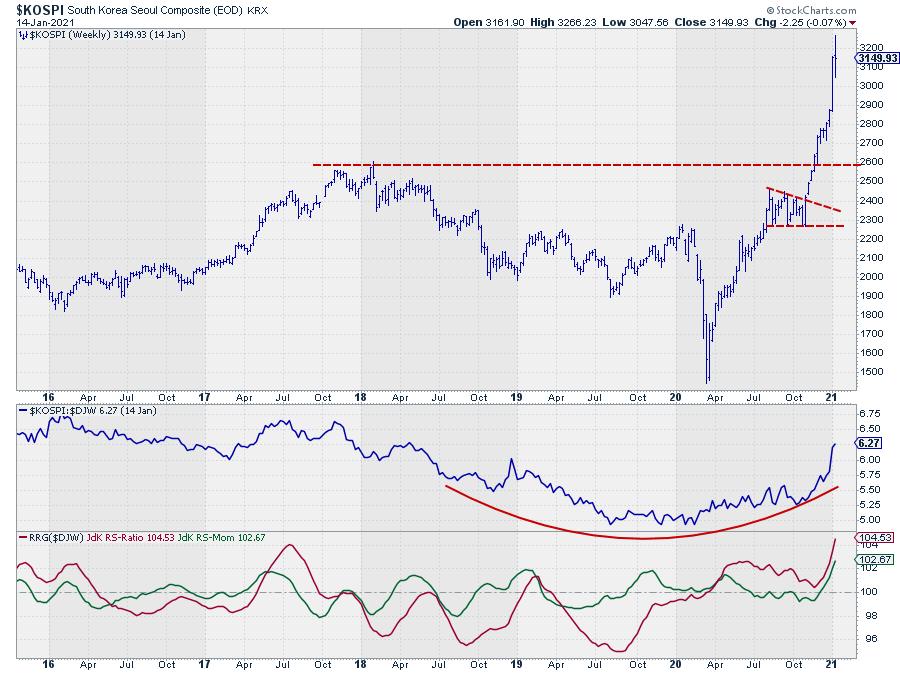
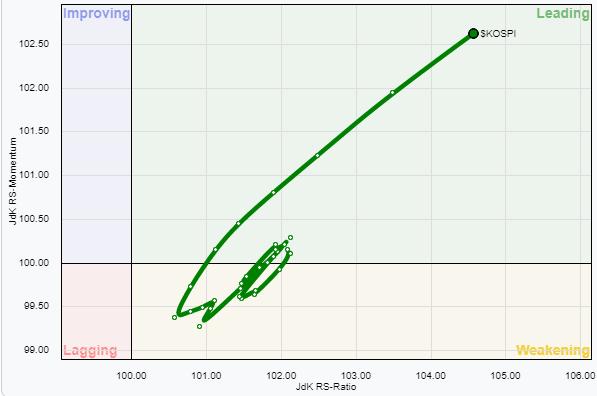 The South Korean KOSPI index is the highest-ranking index on the RS-Ratio scale and the chart above shows why. The break to new highs happened already at the end of November, arguably even earlier, when the market left the consolidation area prior to breaking to a new ATH. The South Korean KOSPI index is the highest-ranking index on the RS-Ratio scale and the chart above shows why. The break to new highs happened already at the end of November, arguably even earlier, when the market left the consolidation area prior to breaking to a new ATH.
The move since the break has been almost vertical, which makes this a high-risk market at the moment. IMHO, the Risk/Reward ratio is now just too high for me to justify immediate entry.
It is, though, a very nice example of a turnaround in relative strength after a multi-year decline that was picked up by the RRG-Lines in April, then went through two short leading-weakening-leading rotations before taking off into leading space.
India ($CNX500)
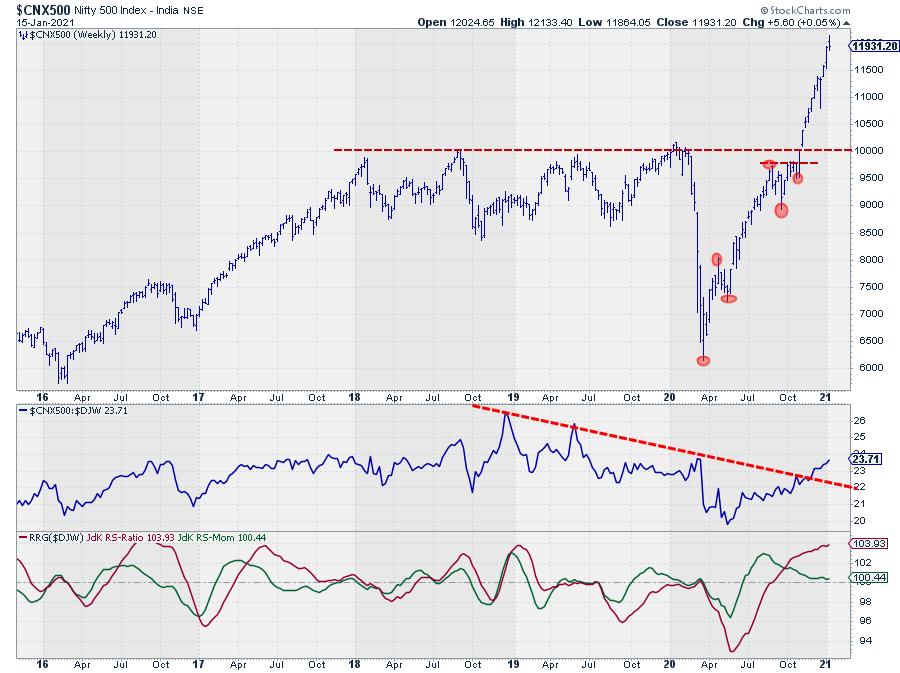
India's NIFTY 500 index is showing a similar picture as the KOSPI. After breaking to new highs, the rally went vertical, which makes it hard to get a good entry level without getting too much downside (price) risk in the position.
On a relative basis, I am watching the green JdK RS-Momentum line. When a new low can be put into place, a further relative strengthening is likely.
However, in order to benefit from such a relative improvement, I would always look to get some sort of off-set or hedge in place to protect the position against a drop in price in absolute terms.
Japan ($NIKK)
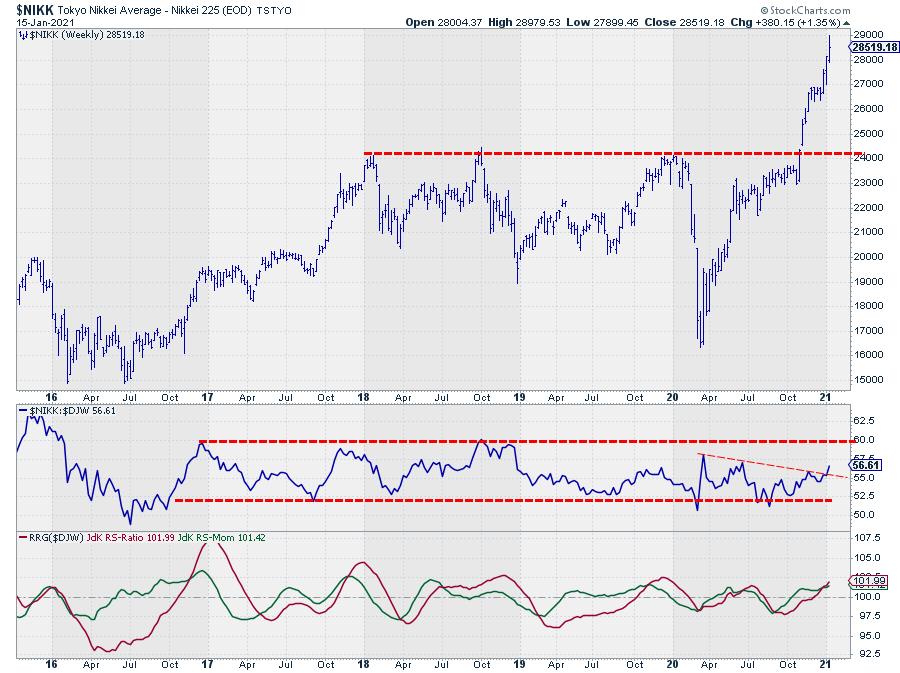
The Japanese Nikkei index is positioned much lower on the RS-Ratio scale and at lower RS-Momentum levels. Still, the price move has been very violent after breaking the heavy horizontal barrier near 24,000.
The relative strength chart looks quite different, as the RS-Line is caught within the boundaries of a trading range that has been in play already since 2017. There is some room for further improvement towards the top of that range in relative strength.
Once that upper boundary can be broken, things will get really interesting.
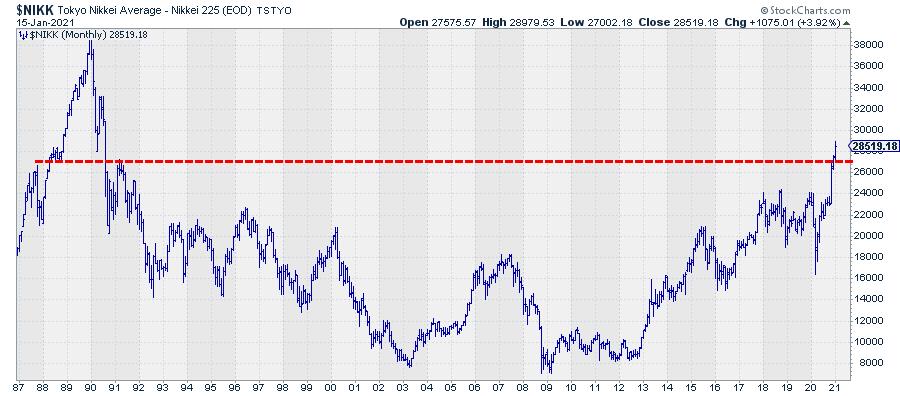
For Japan, it is important to go way back in history. On the chart above, it looks as if Japan just moved to new all-time-highs, just like many other international markets. Truth is, that is not the case. In fact we just moved beyond the highest level for the Nikkei index since 1991.
There is plenty of upside before Japan reaches resistance from its highest point ever. The price chart probably also needs some pause or correction before attractive entry levels become available but, from a relative perspective, it looks as if a big turnaround in favor of Japan is underway.
Europe ($E1DOW)
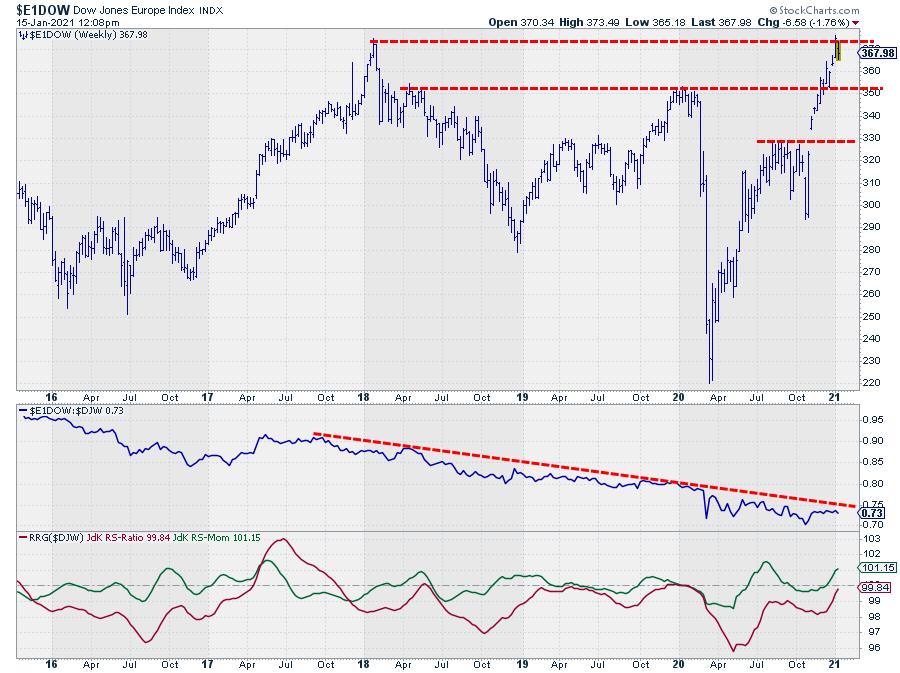
Europe is positioned inside improving and just about to cross over into leading at not-too-high RS-Momentum levels. This makes it a very interesting region to look at.
Several individual European markets have already broken to new highs but the European index has not done so yet. We are pushing against early 2018 highs. The all-time high for this index is even further back, in 2007!!
The relative strength has been in a strong downtrend since 2007 and, more recently, since mid-2017.
If and when the index can break beyond the 2018 resistance level, relative strength will very likely follow higher, which will be interesting to watch as it may offer a good trading opportunity to buy Europe against the US. At the moment. Europe seems to be the region with the most upside potential relative to the world/US in relative terms. Watch for a break beyond 375.
Enjoy your weekend,
#StaySafe, --Julius
My regular blog is the RRG Charts blog. If you would like to receive a notification when a new article is published there, simply "Subscribe" with your email address.
|
| READ ONLINE → |
|
|
|
| The MEM Edge |
| Let This Year's Set of Winners Reveal Themselves To You |
| by Mary Ellen McGonagle |
Swish! It was another winning week for most of the stocks from my bi-weekly MEM Edge Report. In fact, over 74% of the Suggested Holdings from this report outperformed the broader markets, some doing so by a very wide margin.
Today, I'm going to share with you some of the common characteristics of these winning stocks and, more importantly, quick ways that you can potentially identify and get in front of their big moves. This information is based on a proven system that was developed by famed investor, William O'Neil. For those not familiar, O'Neil was the founder of Investor's Business Daily and for 15 years, he was my boss as I traveled the globe advising top portfolio managers and analysts on this system.
To begin, below I'd like to share an image of the biggest percent gainers in the S&P 500 from this past Tuesday, Jan. 12th, and while the S&P was flat for the day, these stocks gained anywhere from 6.8% to 12.5%.
Biggest Gainers From S&P 500 - January 12, 2021
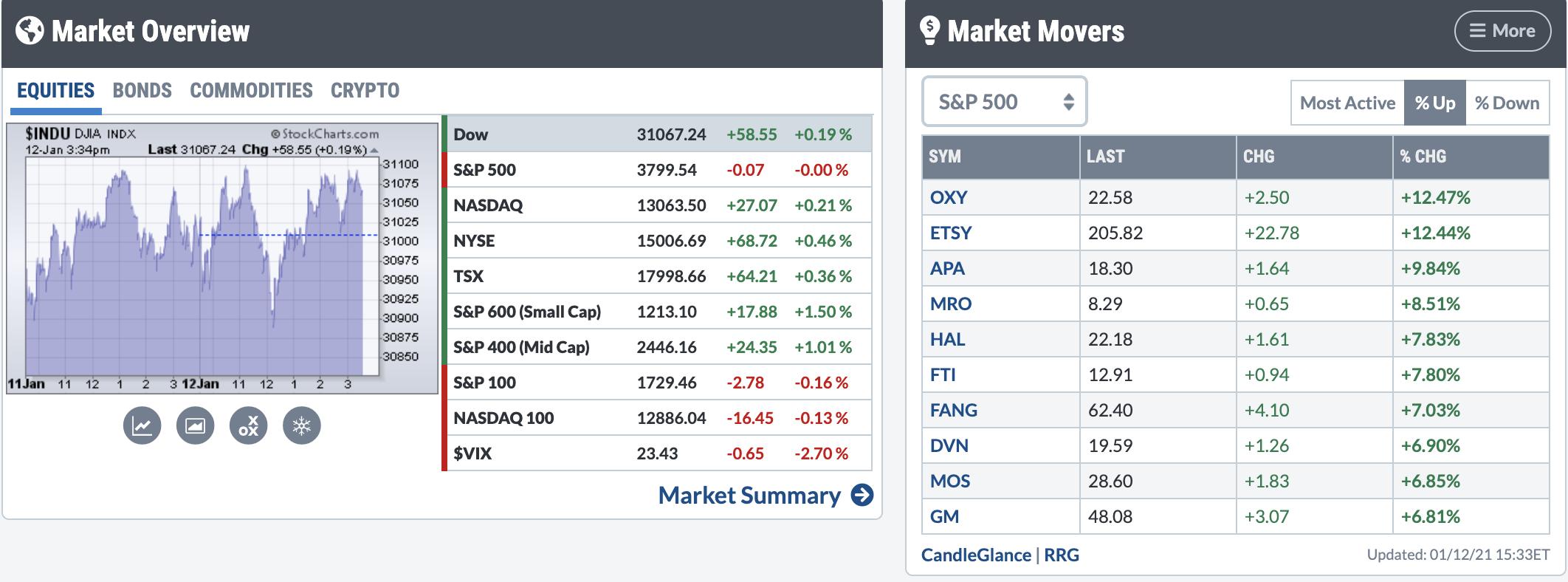
Within this list, 4 stocks are on my MEM Edge Report's Suggested Holdings List. The importance here is that these 4 stocks contain those characteristics common among winning stocks and, in addition, their upside potential remains very much in place.
Let's begin by taking a look at General Motors (GM), which gained 6.8% last Tuesday. GM hit our screens in November, following the company's release of huge 3rd quarter earnings that were ahead of analysts' estimates.
Strong earnings are the number one driver of a winning stock's upward advance.
DAILY CHART OF GENERAL MOTORS CO. (GM)
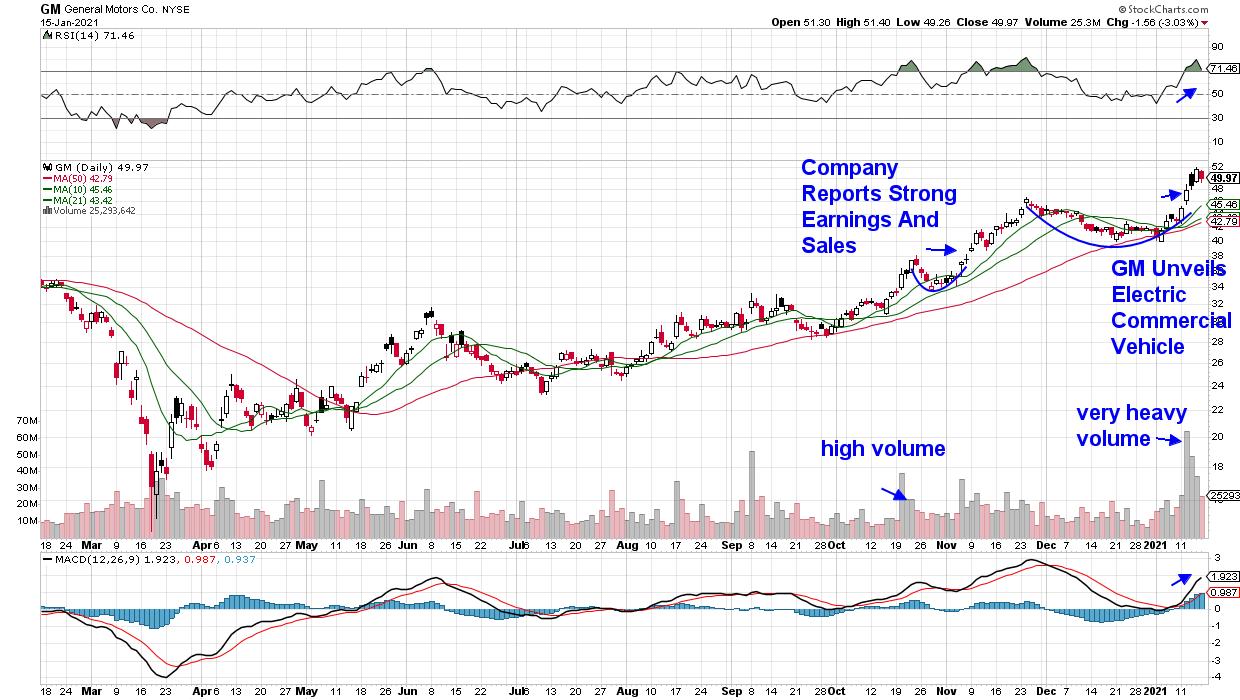
And when a stock gaps up in price on volume in response to those strong earnings, that name needs to make it onto your list of candidates - especially if it breaks out of a base in the process. We added the stock to our Suggested Holdings List here, as shown above.
After a lengthy pullback to its 50-day moving average, where we advised subscribers to stay with the stock, GM hit our Strong Buy list on Jan. 10th as it broke back above its 10- and 21-day moving averages. This week's gap up into a base breakout on tremendous volume will keep the stock on our high conviction list.
The reason for GM's strong advance Tuesday was news that they have a pilot program with FedEx that will lead to the launch of an all-electric cargo van by the end of this year. The innovation that GM is showing is the second of a short list of common characteristics of a winning stock.
Innovation Will Drive Demand in a Company's Products, Which is Another Characteristic of a Winning Stock.
DAILY CHART OF ETSY INC. (ETSY)
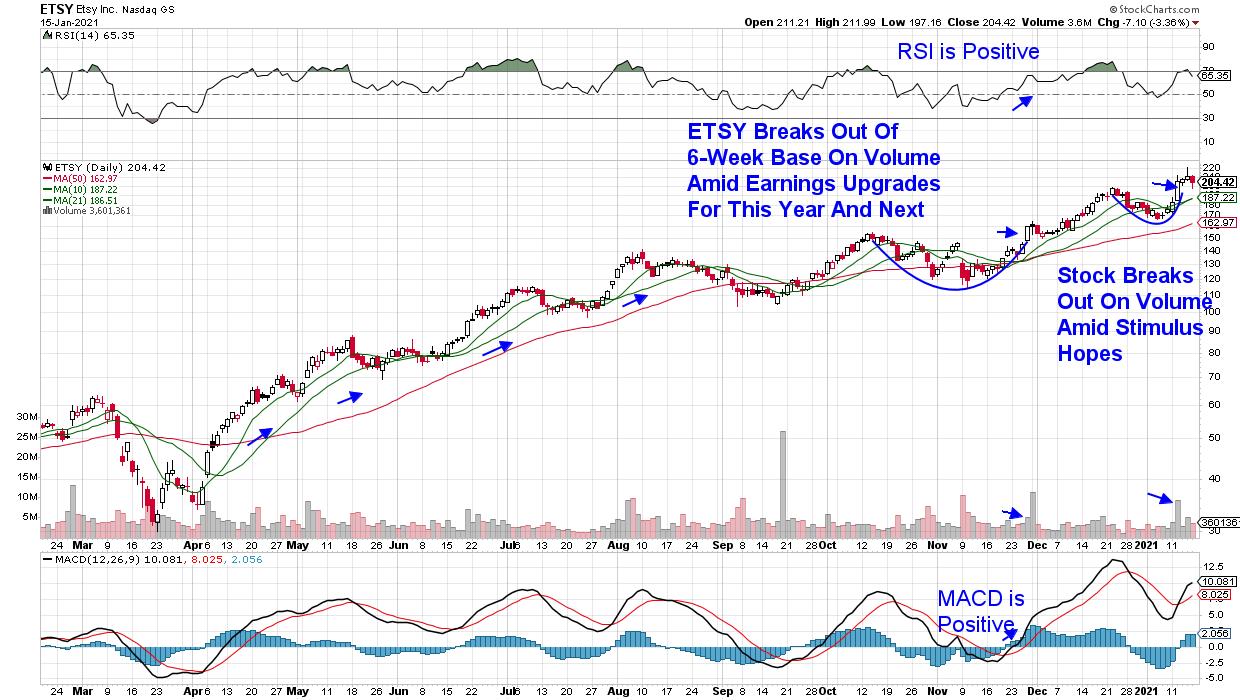
The next big gainer from last Tuesday is Etsy, Inc. (ETSY), which is also on our MEM Suggested Holdings List. The stock had been a big winner for us out of last year's bear market before we removed it early November after its drop below its 50-day moving average.
ETSY's 2nd and 3rd quarter earnings results were well north of 400% vs. 2019 as face mask and then home goods' sales exploded. This innovative platform that connects inventive craftsman with loyal customers is expected to continue to be a winner as the shift to online sales takes hold.
Not every stock that makes it through our strict screening goes on to become a big winner, however, as recent addition Visa (V) can attest to. The good news is that we're quick to remove stocks when they break below key support, so that potential losses are kept to a minimum.
DAILY CHART OF VISA (V)
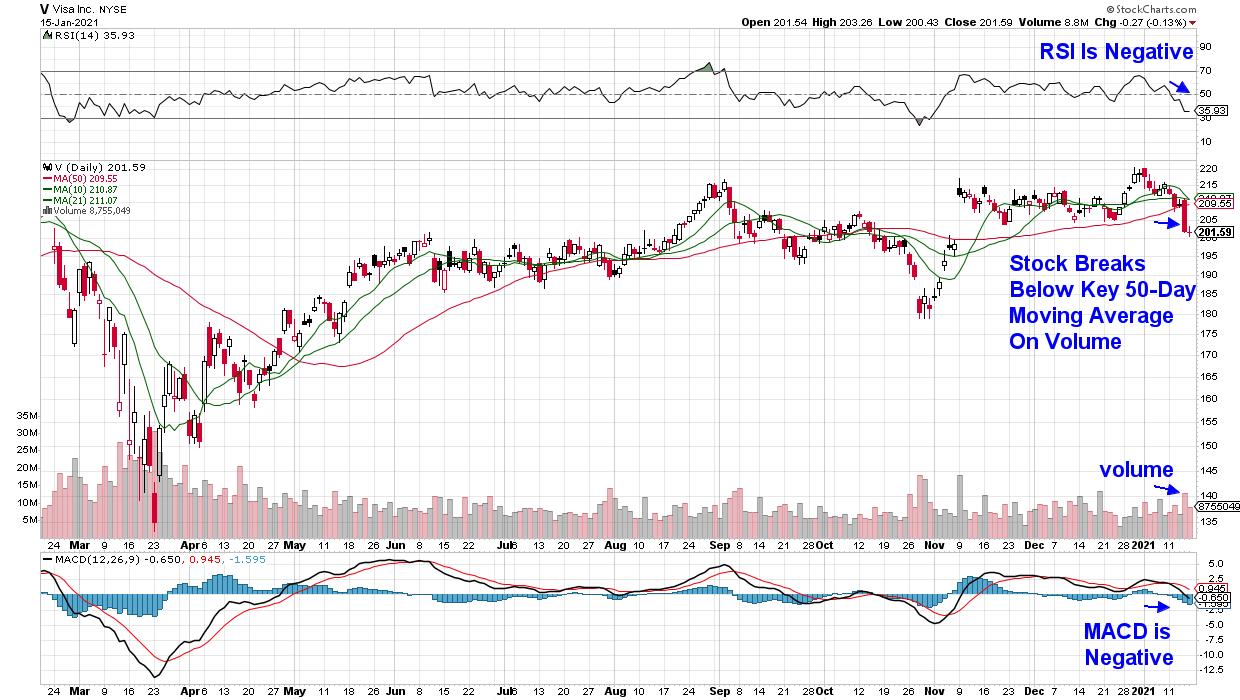
One of the more simple ways to begin screening for big winners is to scan the percent gainers on the S&P 500 on a regular basis. A quick view of the charts can be accessed by clicking the word CandleGlance below the list. From there, you can check the health of each stock's chart to quickly see if it warrants a closer look.
Big Upside Moves on Volume Can Often Signal a Shift to Bullish Sentiment
Industry group strength, which is also very important, will also be revealed such as when a number of Semiconductor stocks appear or Healthcare stocks begin to advance.
If you'd like to be alerted to top candidates that have these and other common characteristics of winning stocks, trial my bi-weekly MEM Edge Report for 4 weeks at a nominal fee. In addition to broader market and sector insights, you'll also receive precise entry points for the many top performers from this report. Use the link above to check out a sample report!
I hope you take advantage of this special offer!
In this week's episode of The MEM Edge, I shared 2 groups that are turning after the stimulus plan announcement. I also discuss how to successfully trade stocks going into earnings season, as well as 1 major pocket of strength and how to capitalize. Watch now!
Warmly,
Mary Ellen McGonagle, MEM Investment Research
|
| READ ONLINE → |
|
|
|
| MORE ARTICLES → |
|
 Chart 1
Chart 1








 FACT: If you investigate the skill sets of the top tier General Managers of your favorite pro sports league, you'll recognize uncanny parallels to the top tier traders described in the Market Wizard books. This is not a coincidence.
FACT: If you investigate the skill sets of the top tier General Managers of your favorite pro sports league, you'll recognize uncanny parallels to the top tier traders described in the Market Wizard books. This is not a coincidence.





 The South Korean KOSPI index is the highest-ranking index on the RS-Ratio scale and the chart above shows why. The break to new highs happened already at the end of November, arguably even earlier, when the market left the consolidation area prior to breaking to a new ATH.
The South Korean KOSPI index is the highest-ranking index on the RS-Ratio scale and the chart above shows why. The break to new highs happened already at the end of November, arguably even earlier, when the market left the consolidation area prior to breaking to a new ATH.























